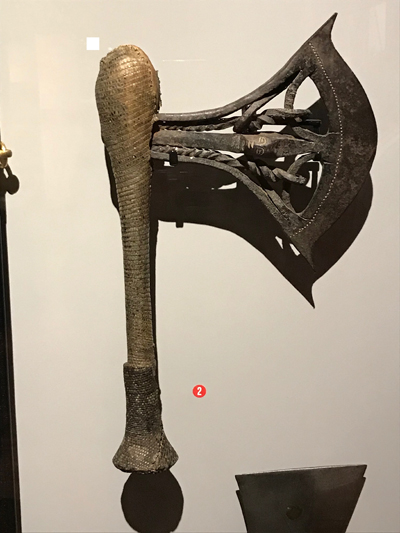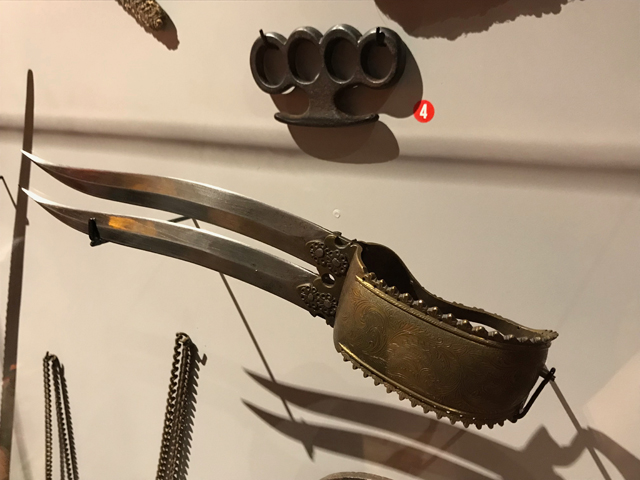There are some scary looking objects on display at Milwaukee Public Museum, 800 W. Wells St., beginning Saturday, Oct. 7.
That’s when the museum’s latest featured exhibition, "Weapons: Beyond the Blade," opens. The show, with more than 180 objects – most from MPM’s own collections – includes knives, armor, swords, spears and the like, many with brutal profiles.
The objects come from more than 50 countries and date back to as far as 10,000 BCE.
There is an arrow from Custer’s last stand and a piece of the oldest bow ever found, uncovered in Switzerland. Except for about a half-dozen borrowed objects, the rest all come from the museum’s collection.
"I went through about 3,000 of the weapons in MPM’s collections when selecting for this exhibition," said museum’s Anthropology Curator of Collections Dawn Scher Thomae.
"All of these items – whether it’s an arrow, a sword, a shield, a gun, armor, a sculpture or a painting – have shaped human history. While some of them are objects of hostility, they all have another story that highlights national identity, personal status or artistic expression, too."
The show is not meant to sensationalize violence, but rather, in the words of an online Q&A about the show, to "address an important topic that resonates both locally and globally.
"Part of MPM’s mission is to inspire curiosity about our world’s natural and cultural diversity. One way we do this is to put on exhibitions, like ‘Weapons: Beyond the Blade,’ that can foster a deeper understanding of our shared past. It is our hope that highlighting the history of weapons will lead to a greater perspective of the complexity of history and spark dialogues about the human condition in the past and the present."
The timing of the opening of the show – which has been scheduled and in preparation for months – is unfortunate, but said Scher Thomae, "This isn’t about a single event. It deals with the greater history (of humans)."
As an example, standing near the entrance to the show, Thomae shows me a case with a couple dozen arrowheads, each from a different civilization around the world, including cultures in Asia, in Ireland, in Italy and in Wisconsin.
These, she explains, are a testament to human innovation.
"Through trial and error, these different civilizations all created arrow points," she says, explaining that despite the lack of contact between these cultures, humans across the globe all arrived at basically the same successful design.

Weapons, Thomae – and the show – explains, were developed to help humans face danger and survive. But they also had ceremonial uses, as a number of objects in the exhibition demonstrate. And, one panel reminds us, many have sporting uses, including swords and rifles and bows and arrows.
They are also objects of cultural identity and crop up as symbols in all kinds of places, like the arrows on the back of the dollar bill, the sword held by the king of spades in a deck of cards and even in sports and business logos.
"We also wanted to create a thematic exhibition that had a broad narrative," the Q&A says. "The exhibit provides a historical overview of the various uses and meanings of weapons, including and beyond their role as objects of hostility. It explores evolving technologies, art, innovation and both personal and cultural identities."
Interestingly, there are very few firearms in the show. The sole exceptions comes at the end, where there are three, including two extremely old examples, along with a panel that poses questions about how we view guns. (One other combination revolver, brass knuckles and knife – pictured below – is also included.)

Perhaps, a show that asks these questions isn’t unfortunately timed, but, rather perfectly suited to the kinds of discussions we should be having today.
"When I decided to do ‘Weapons,’ I knew it wasn’t a safe topic," said Thomae. "It’s a conversation we’re having every day, both locally and nationally. This exhibit presents an opportunity to provide some historical context to the larger understanding of weapons. Hopefully, it will get people to engage with each other in a way we’re unable to when we’re just looking at the headlines."
"Weapons: Beyond the Blade" runs through Jan. 1, 2018. Admission is free for museum members, $21 for adults, $14 for children ages 5-12, and $16 for seniors age 65 and up. Children 4 and under are free. Admission includes general museum admission and one free planetarium program.
Born in Brooklyn, N.Y., where he lived until he was 17, Bobby received his BA-Mass Communications from UWM in 1989 and has lived in Walker's Point, Bay View, Enderis Park, South Milwaukee and on the East Side.
He has published three non-fiction books in Italy – including one about an event in Milwaukee history, which was published in the U.S. in autumn 2010. Four more books, all about Milwaukee, have been published by The History Press.
With his most recent band, The Yell Leaders, Bobby released four LPs and had a songs featured in episodes of TV's "Party of Five" and "Dawson's Creek," and films in Japan, South America and the U.S. The Yell Leaders were named the best unsigned band in their region by VH-1 as part of its Rock Across America 1998 Tour. Most recently, the band contributed tracks to a UK vinyl/CD tribute to the Redskins and collaborated on a track with Italian novelist Enrico Remmert.
He's produced three installments of the "OMCD" series of local music compilations for OnMilwaukee.com and in 2007 produced a CD of Italian music and poetry.
In 2005, he was awarded the City of Asti's (Italy) Journalism Prize for his work focusing on that area. He has also won awards from the Milwaukee Press Club.
He has be heard on 88Nine Radio Milwaukee talking about his "Urban Spelunking" series of stories, in that station's most popular podcast.







